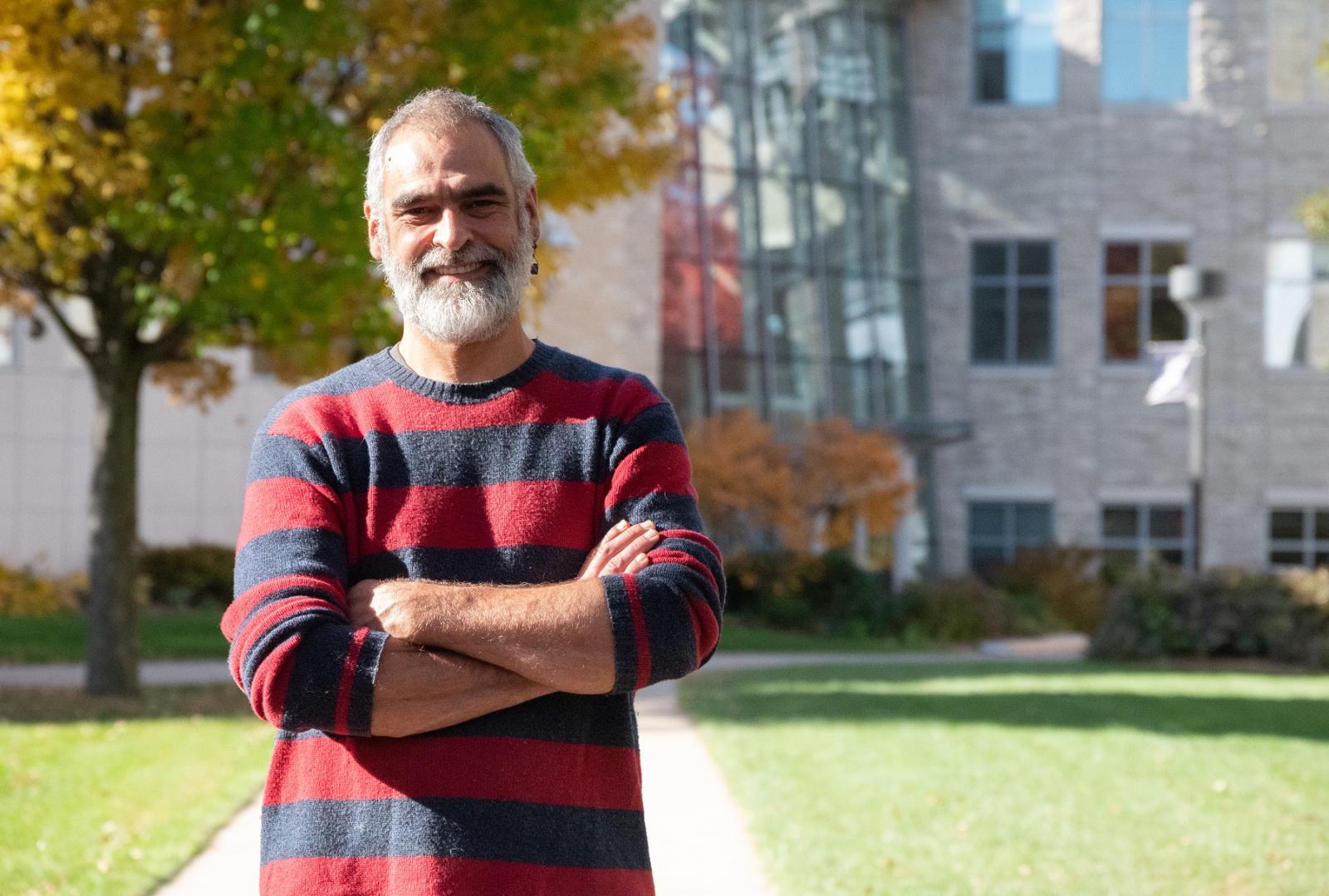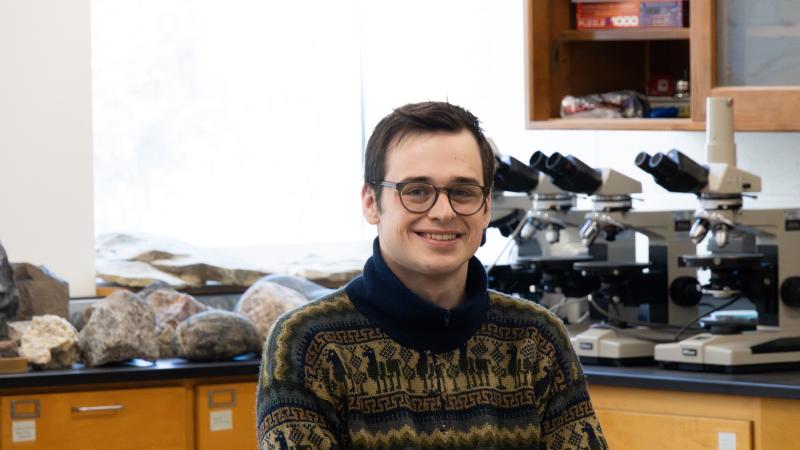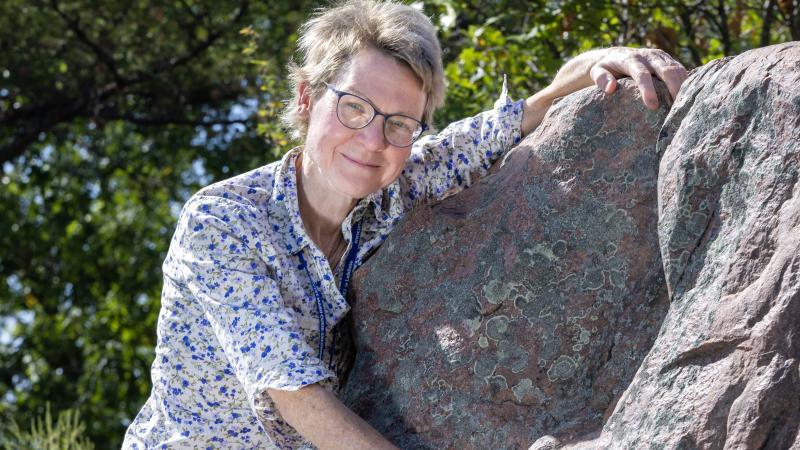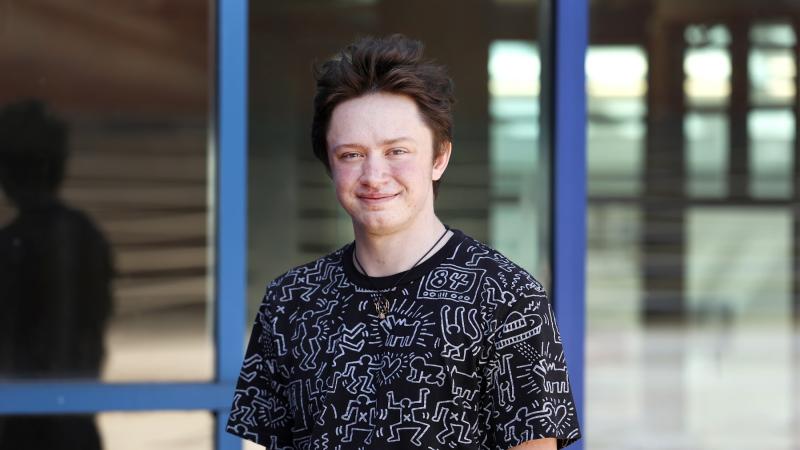About the series: On Main Hall Green With … is an opportunity to connect with faculty on things in and out of the classroom. We’re featuring a different Lawrence faculty member each time — same questions, different answers.
---
Andrew Knudsen, a professor of geosciences at Lawrence University, is at home in Wisconsin’s Northwoods.
Through the study of rocks—banded iron formations in particular—Knudsen connects with the Earth via his research and teaching. He brings students along—literally—on his academic adventures, often in northern Wisconsin, including annual trips to the Penokee Hills, 50 miles of spectacular ridges, rock formations, and trails that run through Ashland and Iron counties on the southern edge of Lake Superior. The study of the rocks connects students with deep geologic history as well as environmental complications tied to our water, air, and other natural resources.
Study our planet’s unique features while considering creative solutions to some of the world’s greatest challenges.
Knudsen, whose academic interests include environmental mineralogy and low-temperature geochemistry, has been on the Lawrence faculty since 2003. He received a bachelor’s degree from Hamilton College and earned his Ph.D. from the University of Idaho.
We caught up with him to talk about interests in and out of the classroom.
In the classroom
Inside info: What’s one thing you want every student coming into your classes to know about you?
I am in constant awe of this incredible planet that we call home. Not only do we reside on, but we are also a fundamental part of Earth. I consider myself incredibly lucky to spend my career striving to better understand Earth and our relationship with it. That I get to share this passion with my students is just awesome.
Getting energized: What work have you done or will you be doing at Lawrence that gets you the most excited?
Easy! My study of banded iron formations (BIF) gets me really excited. To start, these are eye-catchingly beautiful rocks with their stripes of steely grays and deep reds. In studying these ancient rocks, I have focused on the stories they tell about the evolution of our atmosphere as oxygen became more prevalent in the air some 2 billion years ago as photosynthetic organisms reshaped our planet. Not only that, but here in Wisconsin, these rocks are preserved as the backbone of the Penokee Hills, remnants of an ancient, massive mountain range that stood as tall as the Alps billions of years ago. To make it even more exciting, these mountains formed as plates collided in an important step in the assembly of our continent. Finally, these rocks, forming a long and tough ridgeline running east-west across northern Wisconsin, impacted the flow of the glaciers more recently (geologically speaking), playing a part in the giant sheets of ice carving out Lake Superior and the landscape of Wisconsin. So, the BIF in Wisconsin connects to the air we breathe, the land below our feet, and the shape of the water in our region. Amazing! I carry a small piece of BIF in my pocket to remind me of the amazing stories the rocks can share with us. Perhaps the best part of all, is that I get to take a group of students up to the Penokee Hills each fall to share these incredible stories with them.
Going places: Is there an example of somewhere your career has taken you (either a physical space or something more intellectual, emotional, or spiritual) that took you by surprise?
Yes! That place is a sandy beach on the shores of Lake Superior at the mouth of the Bad River, sitting with my class by a fire of driftwood collected on the beach, listening to the stories of Mike Wiggins Jr., a tribal elder and leader of the Bad River Band of Lake Superior Ojibwe. The Bad River (or Mashkiiziibii-Medicine River, in Ojibwe) has its headwaters in the Penokee Hills, then flows to Lake Superior. My students and I visit with Mike the day after we visit the incredible rocks of the Penokee Hills. Mike’s stories help weave humans into the rich geological and ecological story of this incredible place.
Out of the classroom
This or that: If you weren’t teaching for a living, what would you be doing?
I would probably be spending as much time in my canoe on some lake up north. But I’d still be looking at rocks and talking about geology until my family and my dog couldn’t take it anymore. So, it’s probably best that I get to teach at Lawrence!
Right at home: Whether for work, relaxation or reflection, what’s your favorite spot on campus?
I really enjoy spending time by the river. The flow of the water is calming and centering for me.
One book, one recording, one film: Name one of each that speaks to your soul? Or you would recommend to a friend? Or both?
There are so many incredible books. I am going to go with Gathering Moss by Robin Wall-Kimmerer. It is a simply wonderful book about moss, the beautiful and humble places that moss grows, and also her incredible story of being a scientist, indigenous woman, and a mother. Moss, not unlike rocks, is quite beautiful and amazing, but often overlooked, and it asks that you be willing to get down on your hands and knees with a hand lens to your eye to fully appreciate their beauty. Her writing is truly incredible!
Greg Brown is a singer-songwriter from southern Iowa. I love all his works, but he has a live album, The Live One, that is incredible. This recording captures his humor, story-telling, and incredible poetry. His deep and gravely baritone voice paints images of beautiful yet humble landscapes: a trout stream in the U.P., a small, wooded farm in southern Iowa, or the hills of the Driftless region. His lyrics and storytelling get at what it means to be a human in relation with other humans and the land around us. He sings about his grandmother’s canned goods still having the taste of summer in them, asking her to pass “some more potatoes and a thunderstorm.” I love that imagery.
The Rise and Fall of the Great Lakes is a wonderfully campy short film produced by the National Film Board of Canada from 1969. It follows a bearded, flannel-clad traveler as he paddles his wood-canvas canoe through geologic history, comically experiencing the formation of the Great Lakes. What could be more riveting. Add in a delightful square dance tune summarizing the geologic history of the Great Lakes and you have a true classic.
More faculty profiles from the On Main Hall Green With ... series can be found here




